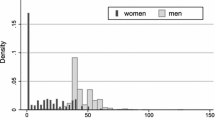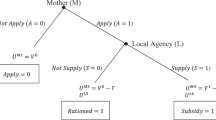Abstract.
Despite the increasing prevalence of nonparental child care, many parents in the United States care exclusively for their young children, even when both parents work. We examine reasons for non-consumption of child care by estimating double-hurdle, tobit and dominance models of the demand for nonrelative child care. Our results indicate that parents' decision whether to use any nonrelative child care is guided by different considerations than the decision of how much care to use. Furthermore, our findings are consistent with the hypothesis that some parents are not interested in nonrelative care, regardless of its price or nonmaternal income.
Similar content being viewed by others
Author information
Authors and Affiliations
Additional information
Received: 27 January 2000/Accepted: 20 June 2001
Rights and permissions
About this article
Cite this article
Joesch, J., Hiedemann, B. The demand for nonrelative child care among families with infants and toddlers: A double-hurdle approach. J Popul Econ 15, 495–526 (2002). https://doi.org/10.1007/s001480100112
Issue Date:
DOI: https://doi.org/10.1007/s001480100112




